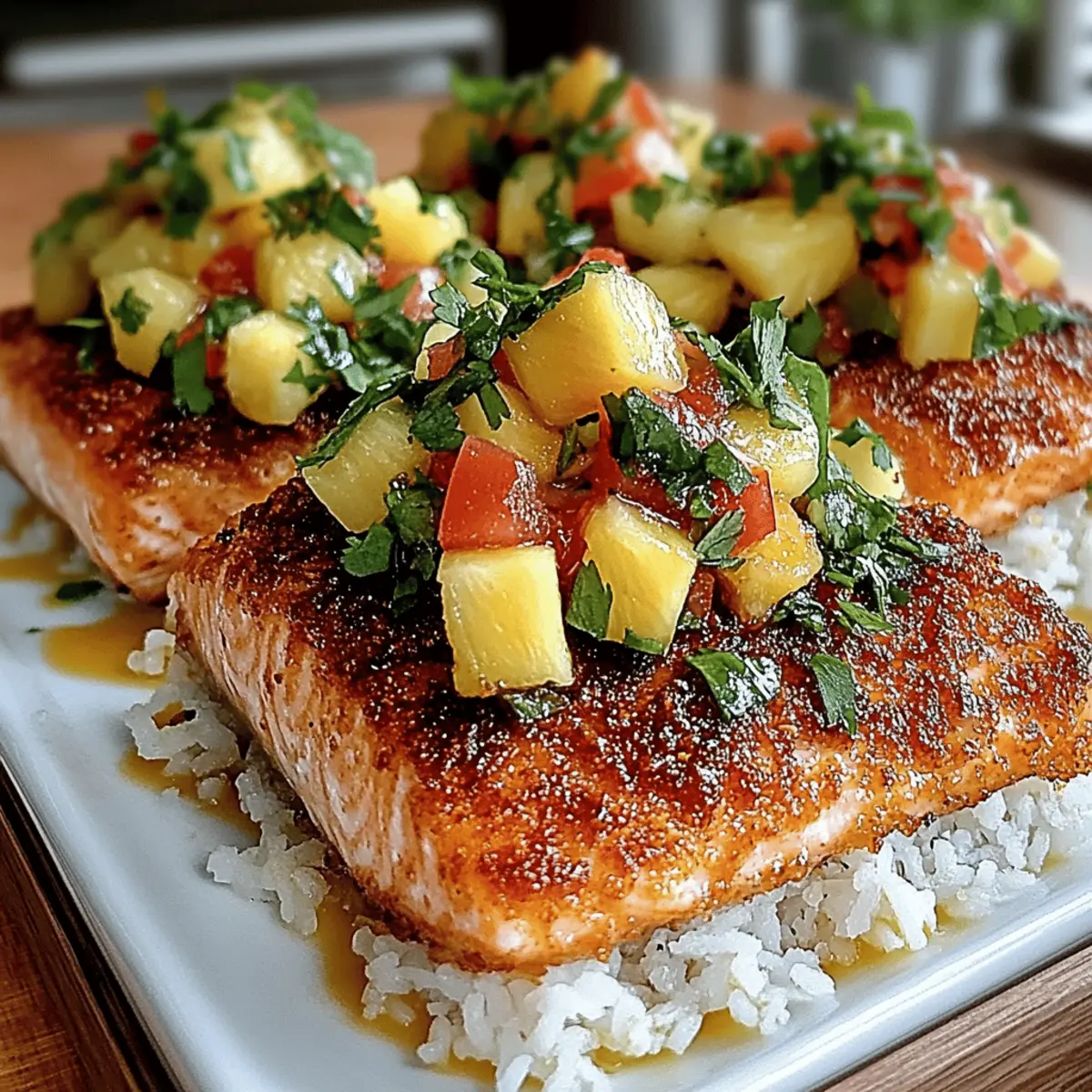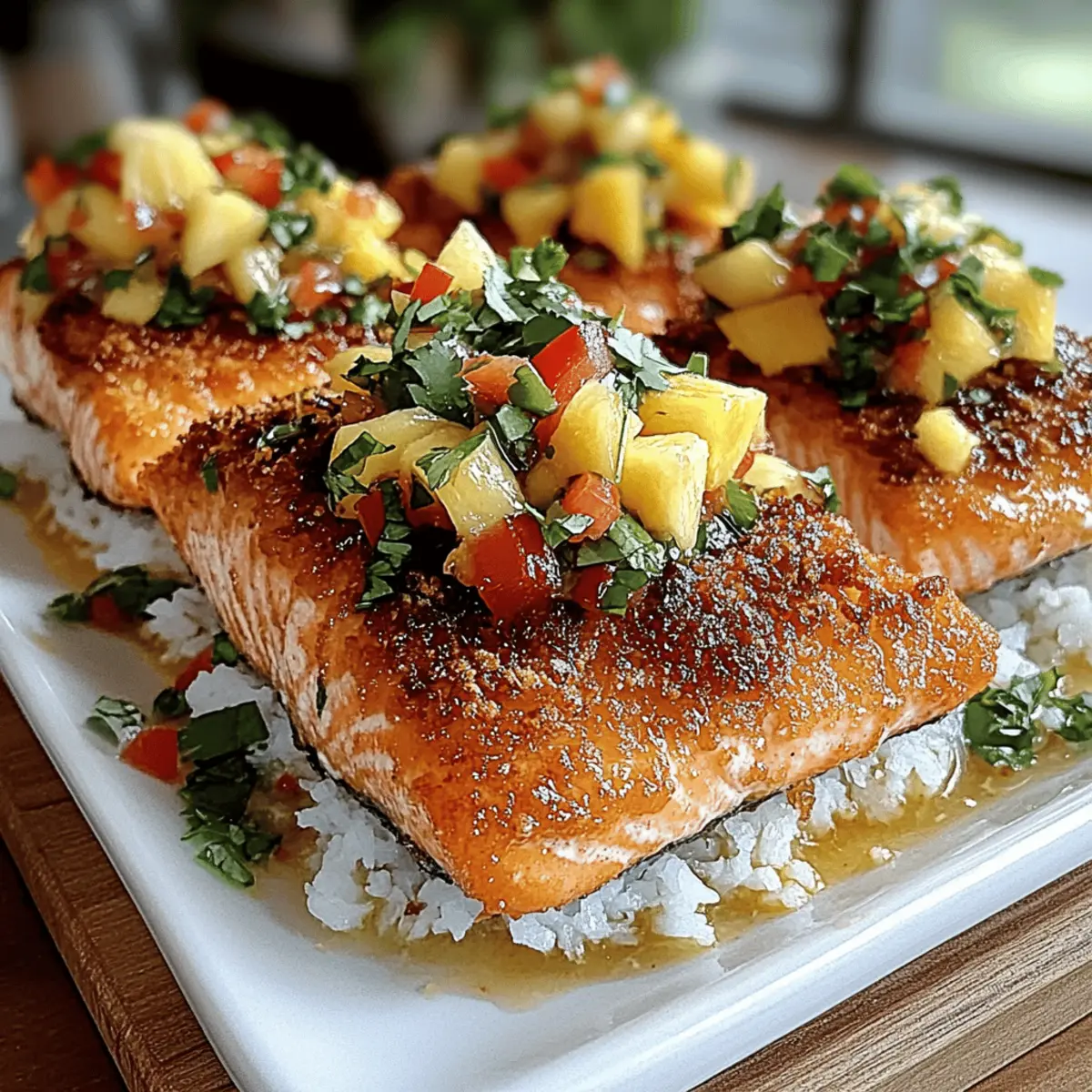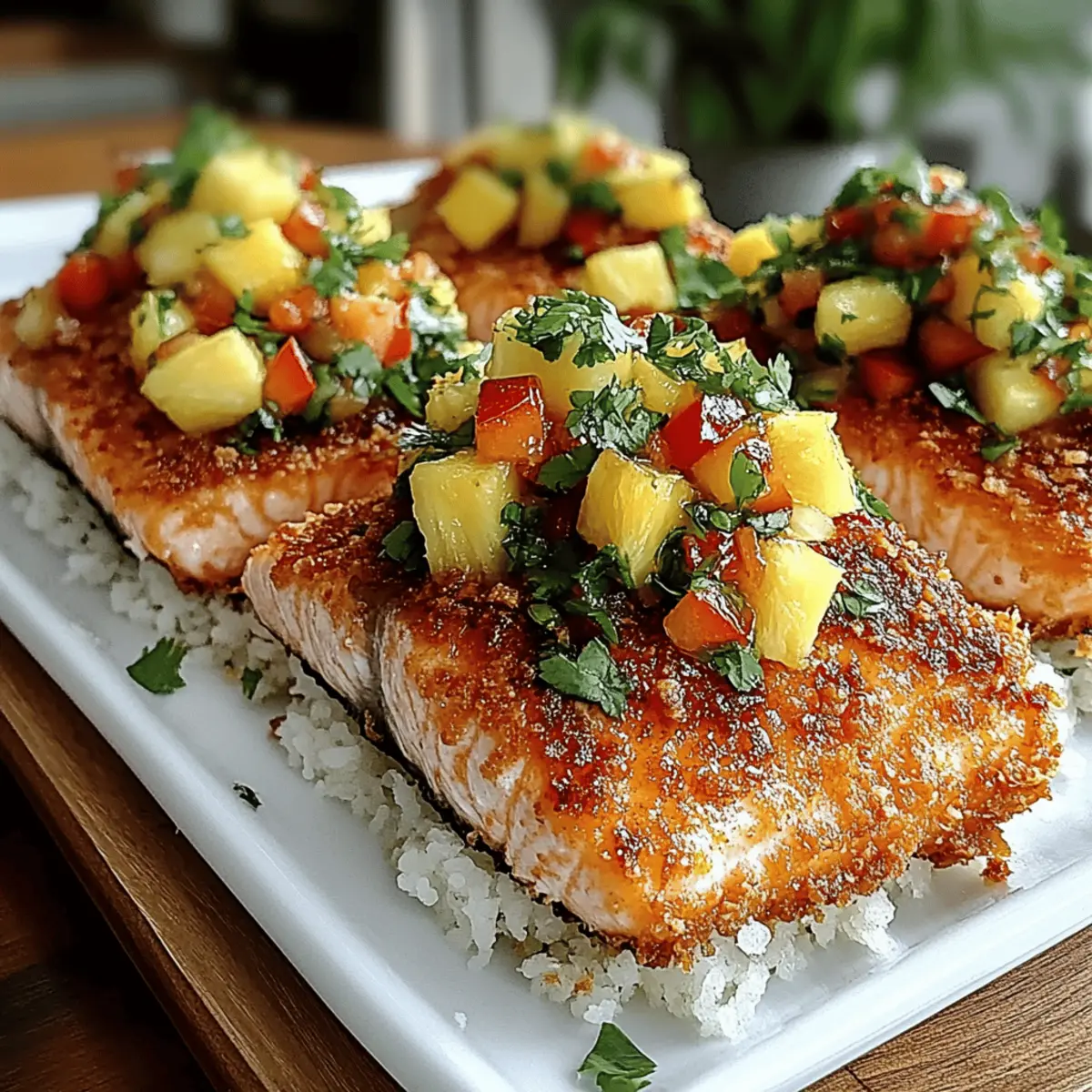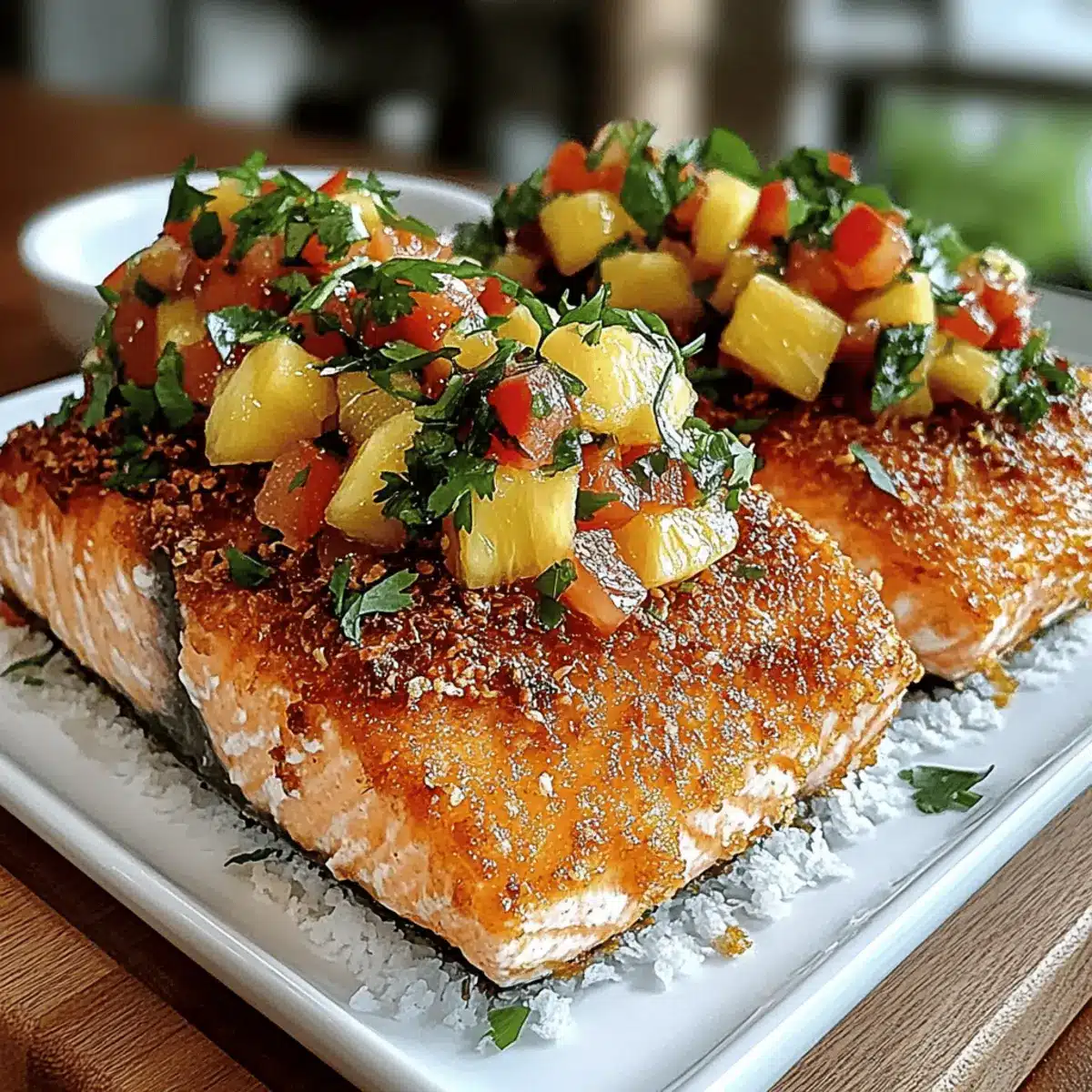The moment I took my first bite of Coconut Crusted Salmon with Pineapple Salsa, I was transported to a sun-soaked beach, the sound of waves mingling with flavors of the tropics. This recipe is not only a quick triumph for weeknight dinners, but it’s also a showstopper for gatherings, easily impressing guests with minimal effort. The delightful crunch of the coconut-panko crust paired with the sweet and tangy freshness of pineapple salsa creates an irresistible culinary experience. Plus, it’s a healthy option that fits perfectly into nut-free and gluten-free diets, making it a worry-free addition to your meal rotation. What playful twist will you add to your version of this dish?

What Makes This Salmon Recipe Unique?
Tropical Bliss: The combination of flaky salmon with sweet pineapple salsa transports your taste buds to a beach paradise.
Two Cooking Methods: Whether you prefer baking or frying, this recipe caters to your cooking style, making it adaptable for any home chef.
Crispy Texture Delight: The coconut-panko crust not only offers a delightful crunch but also locks in moisture, ensuring a perfectly cooked salmon every time.
Healthy and Wholesome: With a focus on nut-free and gluten-free options, this dish aligns with various dietary preferences, allowing everyone to enjoy it without worry.
Crowd-Pleasing Appeal: Perfect for weeknight dinners or festive gatherings, this recipe guarantees compliments, and you can even elevate it by serving with coconut jasmine rice or a refreshing salad.
For more delightful flavor combinations, check out my recipe for Ghoul Gheroni Cheese, and let your creativity soar!
Coconut Crusted Salmon Ingredients
• Dive into the tropical magic with these essential ingredients!
For the Salmon
- Salmon Fillets – A rich source of omega-3 fatty acids; opt for wild-caught for superior flavor.
- Unsweetened Shredded Coconut – Adds a sweet crunch to the crust; fresh coconut intensifies the taste.
- Panko Breadcrumbs – Creates a light and crispy texture; gluten-free panko is perfect for sensitive diets.
- All-Purpose Flour – Helps the egg wash stick; swap with gluten-free flour for a gluten-free option.
- Large Eggs – Acts as a binding agent for the coating; no substitutions needed.
- Salt and Pepper – Essential for seasoning; adjust to your taste.
For Cooking
- Coconut Oil or Olive Oil – Enhances flavor when frying; avocado oil is great for high-heat cooking.
For the Pineapple Salsa
- Fresh Pineapple, Diced – The star ingredient that brings sweetness and acidity; opt for canned if necessary.
- Red Bell Pepper, Finely Chopped – Adds sweetness and vibrant color to the salsa.
- Red Onion, Finely Chopped – Provides a zesty sharpness; green onion can be used for a milder taste.
- Jalapeño, Seeded and Minced – Offers a spicy kick; adjust based on your preference.
- Juice of Lime – Brightens the flavors; fresh lemon juice is a fine substitute.
- Fresh Cilantro, Chopped – Adds a refreshing note to the salsa; parsley works if you prefer a lighter flavor.
- Salt for Salsa – Balances the overall flavor.
Get ready to transform your kitchen into a tropical haven with this Coconut Crusted Salmon with Pineapple Salsa!
Step‑by‑Step Instructions for Coconut Crusted Salmon with Pineapple Salsa
Step 1: Prepare the Salsa
In a mixing bowl, combine diced fresh pineapple, finely chopped red bell pepper, red onion, minced jalapeño, and freshly squeezed lime juice. Toss in chopped cilantro and season with salt to taste. Let the salsa sit for at least 15-20 minutes to allow the flavors to meld. This refreshing pineapple salsa will be the perfect complement to your Coconut Crusted Salmon.
Step 2: Preheat Your Oven or Skillet
Begin by preheating your oven to 400°F (200°C) for baking or heat a skillet over medium heat for frying. Add a tablespoon of coconut oil to the skillet, allowing it to melt and warm up. This step will prepare the cooking surface for your delicious Coconut Crusted Salmon, ensuring a crispy finish.
Step 3: Set Up the Breading Station
Prepare your breading station by placing three bowls side by side. In one bowl, add seasoned all-purpose flour; in another, beat large eggs until smooth. In the last bowl, mix together unsweetened shredded coconut and panko breadcrumbs. This organized setup will streamline the breading process when coating your salmon fillets.
Step 4: Bread the Salmon
Take your salmon fillets and pat them dry to remove excess moisture. Dredge each fillet in the flour, ensuring it’s well-coated, and then dip it into the egg wash for an even layer. Finally, generously cover the fillets with the coconut-panko mixture, pressing the mixture to adhere. This will form a delicious, crunchy crust on your Coconut Crusted Salmon.
Step 5: Cook the Salmon
If you’re baking, place the breaded salmon fillets on a greased baking sheet and bake for 12-15 minutes until they are golden brown and cooked through. For frying, gently place the salmon fillets in the heated skillet, cooking for about 4-5 minutes on each side until golden crispy. Keep an eye on them to ensure they don’t overcook.
Step 6: Serve with Salsa
Once your Coconut Crusted Salmon is perfectly cooked, remove it from the oven or skillet and let it rest for a moment. Plate the salmon generously topped with the vibrant pineapple salsa. This dish not only looks stunning but offers a delightful balance of flavors, making your meal unforgettable.

Coconut Crusted Salmon Variations
Feel free to let your kitchen creativity shine as you customize this recipe with exciting twists and substitutions!
- Gluten-Free Alternative: Use gluten-free panko or ground almonds instead of traditional breadcrumbs to cater to dietary needs.
- Vegan Option: Swap salmon for firm tofu, breading it similarly and cooking until golden for a delightful plant-based version.
- Citrus Zest: Add lime or lemon zest to the breading for an extra zing, brightening the dish with a refreshing twist.
- Heat Lovers: Mix diced serrano or habanero peppers into the salsa for a spicy kick that balances the sweetness of pineapple.
- Herb Infusion: Substitute cilantro in the salsa with fresh basil for a unique flavor profile that pairs beautifully with the salmon.
- Savory Crunch: Incorporate crushed nuts like macadamias or almonds into the coconut-panko crust for added texture.
- Salsa Variations: Experiment with mango or peach instead of pineapple for the salsa, creating a different fruit profile that sings with tropical flavors.
- Coconut Jasmine Rice: Pair the salmon with coconut jasmine rice for a cohesive tropical theme, enriching each bite with creamy coconut notes.
For more delicious twists, consider trying another family favorite, like my Ghoul Gheroni Cheese, and take your culinary journey to new heights!
Expert Tips for Coconut Crusted Salmon
Dry the Salmon: Ensure your salmon fillets are completely dry before breading; moisture can prevent the crust from sticking well.
Flavor Infusion: Let your salsa sit for 15-20 minutes before serving; this allows the ingredients to meld and enhances the flavor profile.
Cooking Check: Keep a close eye on the salmon while cooking; overcooked salmon becomes dry and loses its delicate texture.
Substitutions Matter: Always consider your dietary needs—like using gluten-free panko—so everyone can enjoy this Coconut Crusted Salmon dish.
Keep it Crisp: For the best crust, make sure your oil is hot enough before frying; a cold oil will result in a soggy coating.
Storage Tips for Coconut Crusted Salmon
Fridge: Store any leftover Coconut Crusted Salmon in an airtight container for up to 2 days. However, it’s best enjoyed fresh for optimal texture.
Freezer: If you want to freeze the salmon, wrap it tightly in plastic wrap and then aluminum foil before placing it in a freezer bag. It can be frozen for up to 3 months.
Reheating: When ready to enjoy frozen salmon, thaw it in the fridge overnight. Reheat in an oven at 350°F (175°C) for about 10-15 minutes until warm, to maintain the crust’s texture.
Salsa Storage: Store any leftover pineapple salsa in the fridge for up to 3 days. The flavors will deepen over time, making it a delicious topping for other dishes!
Make Ahead Options
These Coconut Crusted Salmon with Pineapple Salsa are a fantastic choice for meal prep! You can prepare the pineapple salsa up to 24 hours in advance, allowing the flavors to meld beautifully while it refrigerates. Simply combine the diced pineapple, red bell pepper, red onion, jalapeño, lime juice, and cilantro, season with salt, and store in an airtight container. For the salmon, bread it a few hours ahead, but avoid cooking it until you’re ready to serve; this ensures the crust stays crispy! When ready to enjoy, either bake or fry the salmon as directed, and pair it with the fresh salsa for a dish that feels like a tropical getaway with every bite.
What to Serve with Coconut Crusted Salmon with Pineapple Salsa
Create a vibrant coastal feast that perfectly balances the tropical flavors of your dish.
- Coconut Jasmine Rice: The creamy texture and fragrant coconut flavor enhance the tropical theme, soaking up the juicy salsa.
- Crispy Green Salad: A refreshing mixture of greens, avocado, and citrus dressing offers a bright contrast to the rich salmon.
- Grilled Asparagus: The slight char and tender crunch of asparagus add a delightful bite, pairing well with the sweet salsa.
- Quinoa Salad: Nutty quinoa mixed with diced vegetables creates a hearty side, while its lightness complements the salmon beautifully.
- Mango Chutney: The sweet and spicy notes of mango chutney deepen the tropical flavor profile, creating a lively addition to the plate.
- Pineapple Mimosas: Sip on a refreshing pineapple mimosa for a tropical twist; the light bubbles and sweetness elevate the dining experience.
- Chocolate Coconut Macaroons: For dessert, these sweet treats provide a delightful closing note, echoing the coconut theme of your meal.

Coconut Crusted Salmon with Pineapple Salsa Recipe FAQs
What type of salmon should I use?
I recommend choosing wild-caught salmon for its superior flavor and higher omega-3 fatty acid content. Farmed salmon is also an option but may have a milder taste. Look for bright, shiny skin with flesh that’s firm and not discolored.
How should I store leftover coconut crusted salmon?
Store any leftover Coconut Crusted Salmon in an airtight container in the refrigerator for up to 2 days. However, for the best texture and flavor, it’s ideal to enjoy it fresh.
Can I freeze coconut crusted salmon?
Absolutely! To freeze, wrap the salmon tightly in plastic wrap, then in aluminum foil, and place it in a freezer bag. This method helps prevent freezer burn and can keep your salmon fresh for up to 3 months. When you’re ready to enjoy it, simply thaw it overnight in the fridge and reheat in a preheated oven at 350°F (175°C) for about 10-15 minutes.
How do I know if my coconut crusted salmon is done cooking?
Keep a close eye on the salmon while cooking! The internal temperature should reach 145°F (63°C). For visual cues, look for the crust to be golden brown and the salmon should flake easily with a fork. Avoid overcooking, as the salmon can become dry and lose its delicious texture.
Can I make this dish if I have dietary restrictions?
Yes, this Coconut Crusted Salmon with Pineapple Salsa is already nut-free and can be gluten-free by using gluten-free panko breadcrumbs and all-purpose flour substitutes. If you have other dietary concerns, feel free to swap any of the ingredients—for example, using firm tofu instead of salmon for a vegan version!

Coconut Crusted Salmon with Pineapple Salsa: A Tropical Treat
Ingredients
Equipment
Method
- In a mixing bowl, combine diced fresh pineapple, finely chopped red bell pepper, red onion, minced jalapeño, and freshly squeezed lime juice. Toss in chopped cilantro and season with salt. Let sit for at least 15-20 minutes.
- Preheat your oven to 400°F (200°C) or heat a skillet over medium heat. Add a tablespoon of coconut oil to the skillet.
- Prepare your breading station with three bowls: one with seasoned all-purpose flour, one with beaten eggs, and one with a mixture of unsweetened shredded coconut and panko breadcrumbs.
- Pat salmon fillets dry, dredge in flour, dip in egg wash, and then coat with the coconut-panko mixture.
- For baking, place salmon on a greased baking sheet and bake for 12-15 minutes until golden brown. For frying, cook in the skillet for about 4-5 minutes on each side.
- Serve the cooked salmon topped with the vibrant pineapple salsa.

Leave a Reply